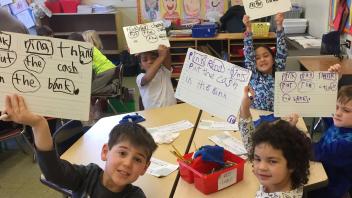Poor spellers often try to memorize a spelling as if it were an arbitrary letter string. Arbitrary strings are terribly hard to remember think how long it takes to learn a phone number and then imagine trying to learn 88,500 phone numbers, the estimated number of words in printed school English.
The following strategy helps the student focus on the pronunciation of a word before seeing its spelling. This helps the student understand that a spelling is a meaningful map of the pronunciation. When spellings are understood as pronunciation maps, they are much easier to remember.
First, try to get students to feel what their mouths are doing as they say the word. Here’s an example:
- Say the word night
- Say each syllable if there are more than one.
- Stretch the word /nnn-iii-t-t-t/
- Work by syllables if necessary.
- If a sound can’t be stretched, stutter it.
- Split up the sounds.
- Work by syllables if necessary.
- First sound? /n/
- Next sound? /i/
- Last sound? /t/
- Count the sounds. 3
- Draw blanks. ___ ___ ___
- The blanks stand for the sounds.
- Put slashes between syllables if necessary.
Next, help the student learn the spelling.
- Record the spelling sound by sound.
- On the first blank, write the letters n __ __
- On the next blank, write the next letters n igh __
- On the last blank, write the last letters n igh t
- If there are silent letters, caret them in.
- Study the spelling.
- Ask, what does [the pattern] say? In our example, what does igh say? Only ask about tricky parts.
- Write the word night
- Give the meaning.
- What does ______ mean? When it’s dark out.
Here’s a shortcut version of the above strategy for studying spelling words:
- Say
- Stretch
- Split up
- Count
- Draw blanks
- Record
- Study
- Write
- Give meaning
